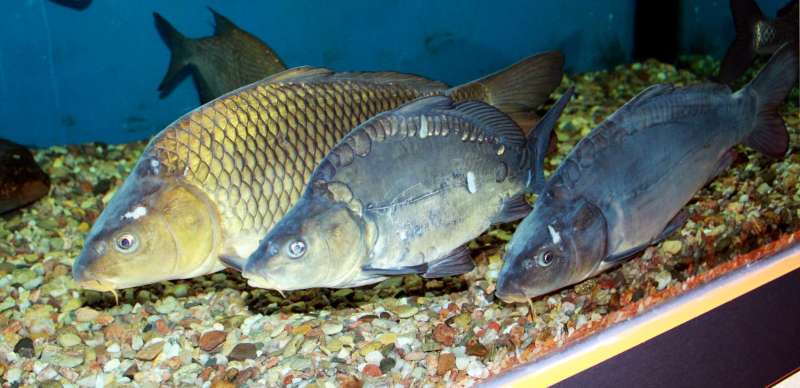August 24, 2016 report
Carp demonstrate rapid de-evolution to get their scales back

(Phys.org)—A team of researchers with members from France, Hungary and Madagascar has found that a type of carp bred to have fewer scales and subsequently released into the wild in Madagascar a century ago has devolved to get its scales back. In their paper published in Proceedings of the Royal Society B, the team describes how they collected large numbers of specimens to study their scales and to look at their DNA and what they found.
Approximately a century ago, a group of monks in Europe embarked on a mission to make carp less work to prepare for eating—they bred them to have fewer and fewer scales over successive generations and were so successful that the fish became known as mirror carp because of their newly reflective properties. Then, in 1912, a group of Europeans released mirror carp into the wild in Madagascar as a food source for people living there—until that time, there were no carp present at all. The program was considered a success as the fish flourished in the new environment. It did not take long for the breeding process to begin reversing itself, however—as early as 1950, people in the area were reporting that the carp were becoming scalier. In this new effort, the researchers sought to better understand the evolutionary process that the fish have been undergoing over the course of the past century.
The study consisted of capturing approximately 700 specimens in Madagascar and analyzing both their scales and DNA. In studying their results, the researchers found that approximately 65 percent of those they caught were fully scaled—back to where they had been before the monks got involved. But surprisingly, they also found that the new scales were not the result of reversing the DNA changes that had occurred during the time they were bred to have fewer scales—those gene changes were still present, which suggested that different genes were involved in rescaling. This meant that the fish had evolved back to its original form over the course of just 100 years, which translated to approximately 40 generations—a mere blip in general evolutionary terms.
The researchers believe the fish devolved back to its original form because scales offer better protection against parasites and predators.
More information: Jean-Noël Hubert et al. How could fully scaled carps appear in natural waters in Madagascar?, Proceedings of the Royal Society B: Biological Sciences (2016). DOI: 10.1098/rspb.2016.0945
Abstract
The capacity of organisms to rapidly evolve in response to environmental changes is a key feature of evolution, and studying mutation compensation is a way to evaluate whether alternative routes of evolution are possible or not. Common carps (Cyprinus carpio) carrying a homozygous loss-of-function mutation for the scale cover gene fgfr1a1, causing the 'mirror' reduced scale cover, were introduced in Madagascar a century ago. Here we show that carps in Malagasy natural waters are now predominantly covered with scales, though they still all carry the homozygous mutation. We also reveal that the number of scales in mutated carps is under strong polygenic genetic control, with a heritability of 0.49. As a whole, our results suggest that carps submitted to natural selection could evolve a wild-type-like scale cover in less than 40 generations from standing polygenic genetic variation, confirming similar findings mainly retrieved from model organisms.
Journal information: Proceedings of the Royal Society B
© 2016 Phys.org
















